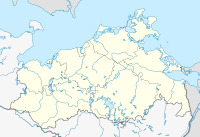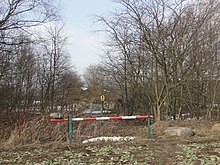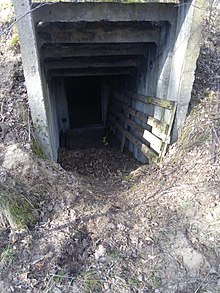Försterhofer Heide nature reserve
Coordinates: 54 ° 14 '52.1 " N , 13 ° 5' 18.3" E
The Försterhofer Heide nature reserve is a 79 hectare nature reserve in Mecklenburg-Western Pomerania, seven kilometers south of Stralsund in the Vorpommern - Rügen district. It was placed under protection on November 25, 1993. The protected area comprises the section of a sander landscape with sandy grass, dwarf shrub heather and a kettle bog with scour.
The current state of the area is assessed as good. The area is easily accessible on public roads from Zarrendorf and Zitterpenningshagen , even if the paths are not paved. The Berlin - Stralsund railway line, also known as the Berlin Northern Railway , runs right next to the nature reserve .
history
The Försterhofer Heide is embedded in a sand landscape that was created in the Velgaster season of the last ice age . The sands reach a thickness of up to three meters. The land was owned by the Zitterpennigshagen and Försterhof monasteries for centuries. They were used as sheep and horse pastures. Sheep still graze in the area in fenced off areas of the heather.
The Försterhofer Heide is an old guarding area. It owes its emergence to a permanent anthropogenic influence over several centuries. Military use from the end of the 19th century to 1990 in combination with extensive grazing favored the emergence and spread of a dry dwarf shrub heather. In 1953 about 30 hectares were afforested with pine trees in the north. 35 hectares are forest areas and belong to the jurisdiction of the State Forest Agency MV. In the south of the heath, a further 9.50 hectares were designated as forest access areas in 2016. At the edge or within these areas there are two open-air habitat types. Two further open-air habitat types are located in the northwest of the Försterhofer Heide and are part of the forest grounds as non-wood flooring.
The Försterhofer Heide is not subject to any tourism or recreational use and is not cut up by settlements, roads and infrastructure. 36.5 ha are designated as grassland field block and are subject to pasture use with sheep.
In 1993 the area was designated as a NSG. The protection purpose is the preservation, development and care of dry and semi-arid lawns with scattered dwarf shrub heaths as well as the preservation of a moored, nutrient-poor small lake. The species and individual rich entomofauna is particularly emphasized. Various maintenance measures have been carried out in the NSG since 1993. According to an agreement from 2001, compensatory and replacement measures were to be implemented in the Försterhofer Heide, including the conversion of the pine forest in the north of the area into a natural deciduous mixed forest.
Military use
From 1891, drill exercises for the Stralsund garrison were carried out on the land. From 1938 the areas were used as a glider airfield for the Hitler Youth. During the GDR era, part of the area was afforested with pine trees. From 1973 to 1990 the Försterhofer Heide served as a practice area for the Stralsund Naval School . Remains of the former military use can still be found today. The bunkers of the NVA are now used as shelter for the bats.
Flora and fauna
The largest part of the nature reserve is currently free of forests and covered with sandy grasslands and dwarf shrub heaths . Typical species are hawkweed , mountain sandbell , common carnation , real bedstraw , field hornwort , silver cinquefoil , hare clover , silvergrass and ragweed . A kettle bog has formed in the pond with rare species such as peat moss , swamp blood-eye , narrow-leaved cottongrass , sedges , fever clover , common pennywort , round-leaved sundew and cranberries . Particularly noteworthy is the biodiversity of the butterflies, of which almost 300 different species have been identified, including rare species such as the owl butterfly and the grass bear .
A serious problem in the Försterhofer Heide is the spread of the late bird cherry. This not only threatens the immediate preservation of the priority LRT 6230 *, but also the preservation of the entire protected area in the medium term. As a result of control measures in the 1990s, the species has conquered almost the entire southeast of the area by means of stick eruptions. To control the late bird cherry, a forest mulcher should be used annually on an area of around 3.50 hectares. In the first few years this should concentrate on pushing back young bird cherry trees in the southeast of the protected area, but later mainly on the valuable areas in the center of the nature reserve.
literature
- Heather 276 . In: Ministry of Environment Mecklenburg-Western Pomerania (Hrsg.): The nature reserves in Mecklenburg-Western Pomerania . Demmler-Verlag, Schwerin 2003, ISBN 3-910150-52-7 , p. 208 f .
Web links
- NSG regulation
- Information in the state portal MV
- Map portal environment of the State Office for the Environment, Nature Conservation and Geology Mecklenburg-Western Pomerania ( information ) with geodata
Individual evidence
- ↑ Moist dwarf shrub heath biotope sheet in the Försterhofer Heide NSG (PDF; 18 kB)
- ↑ Sauerarmmoor biotope arch in the Försterhofer Heide NSG (PDF; 19 kB)






